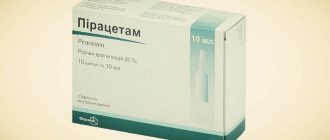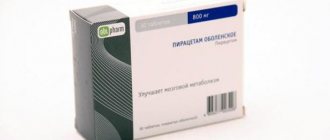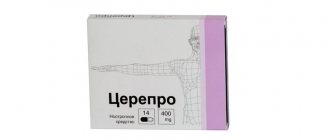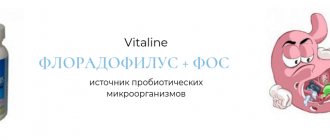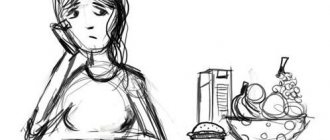Forms of release and composition of the drugs Piracetam and Cinnarizine
Both drugs are available in the form of capsules coated with enteric film.
Composition of Piracetam:
- 400 mg of active ingredient – piracetam;
- magnesium carbonate;
- calcium stearate;
- povidone K-25;
- potato starch;
- opadaray 2 white.
Composition of Cinnarizine:
- 25 mg of active ingredient – cinnarizine;
- lactose monohydrate;
- potato starch;
- colloidal silicon dioxide;
- povidone;
- magnesium stearate.
The drugs are packaged in plastic blisters and placed in cardboard containers: for Piracetam - 10 capsules, for Cinnarizine - 25 tablets.
Pharmacological properties of the drugs
Piracetam is a group of nootropic drugs whose action is aimed at restoring cognitive functions. At the same time, there is a positive effect on the central nervous system.
Action of the drug:
- improvement of metabolic properties in brain tissue;
- restoration and improvement of energy and protein processes in the brain;
- shortening the period of removal of glucose components and, as a result, increasing protective properties to avoid the development of hypoxia;
- increasing the conductivity of neurons responsible for transmitting impulses to the central nervous system;
- rehabilitation after amnestic disorders;
- restoration of blood flow.
Action of Cinnarizine:
- suppression of processes responsible for the flow of calcium ions into the blood;
- decreased muscle activity of smooth muscles;
- suppression of increased histamine production;
- restoration of the functions of the vestibular apparatus;
- reducing excessive activity of the sympathetic system;
- increasing the elasticity of blood vessels.
The combined use of capsules leads to an enhanced effect of both medications. However, such a combination is allowed only after the diagnosis has been established and confirmed.
pharmachologic effect
A combined drug with pronounced antihypoxic, nootropic and vasodilating effects. The components mutually potentiate a decrease in cerebral vascular resistance and help increase blood flow in them.
Piracetam is a nootropic drug. Activates metabolic processes in the brain by enhancing energy and protein metabolism, accelerating the utilization of glucose by cells and increasing their resistance to hypoxia. Improves interneuronal transmission to the central nervous system and regional blood flow in the ischemic area.
Cinnarizine is a selective blocker of slow calcium channels and an antagonist of histamine H1 receptors. It has been established that it inhibits the entry of calcium ions into cells and reduces their content in the plasma membrane depot. Reduces the tone of the smooth muscles of arterioles, reduces their response to biogenic vasoconstrictors (catecholamines, angiotensin and vasopressin). It has a vasodilating effect (especially in relation to cerebral vessels, enhancing the antihypoxic effect of piracetam), without having a significant effect on blood pressure. It exhibits moderate antihistamine activity, reduces the excitability of the vestibular apparatus, and increases the tone of the sympathetic nervous system. Increases the elasticity of red blood cell membranes, their ability to deform, and reduces blood viscosity.
Pharmacodynamics and pharmacokinetics
Piracetam and Cinnarizine together exhibit similar pharmacokinetic and pharmacodynamic properties characteristic of the drugs individually.
When administered orally, medications are quickly absorbed from the gastrointestinal tract. Moreover, bioavailability in both cases reaches maximum efficiency - 100%. The active components have a high absorption capacity, including in relation to the placental barrier.
The maximum concentration of the main components is observed 3-6 hours after taking the capsules.
Drug metabolites are excreted primarily by the kidneys 30 hours after using the medications. The level of excreted metabolites is 95%.
https://www.youtube.com/watch?v=W0lpVgOZn0k
Pharmacokinetics
Suction
After oral administration, the drug is completely absorbed from the gastrointestinal tract.
Cmax of piracetam in plasma is created after 2-6 hours. Bioavailability of piracetam is 100%.
Absorption of cinnarizine is slow. Cmax of cinnarizine in plasma is achieved after 1-4 hours.
Distribution
Piracetam does not bind to plasma proteins. The apparent Vd is about 0.6 l/kg. Piracetam freely penetrates the BBB. The maximum concentration of piracetam in the cerebrospinal fluid is achieved after 2-8 hours. Penetrates into all organs and tissues, penetrates the placental barrier. Selectively accumulates in the cerebral cortex, mainly in the frontal, parietal and occipital lobes, cerebellum and basal ganglia.
The binding of cinnarizine to plasma proteins is 91%.
Metabolism
Piracetam is not metabolized.
Cinnarizine is actively and completely metabolized in the liver by dealkylation with the participation of the CYP2D6 isoenzyme.
Removal
T1/2 of piracetam from blood plasma is 4-5 hours, from cerebrospinal fluid - 8.5 hours. 80-100% of piracetam is excreted unchanged by the kidneys by renal filtration. The renal clearance of piracetam in healthy volunteers is 86 ml/min.
T1/2 of cinnarizine - 4 hours. 1/3 of the metabolites are excreted in the urine, 2/3 in the feces.
Indications for simultaneous use
With the simultaneous use of drugs, the therapeutic effect is enhanced in both cases.
Indications:
- ischemic or hemorrhagic form of stroke;
- damage, trauma to the brain (traumatic brain injury);
- disruptions in the functioning of the sympathetic nervous system;
- atherosclerotic damage to cerebral vessels;
- asthenic syndrome;
- various forms of labyrinthopathy;
- organic psychosyndrome;
- frequent migraine-type headaches;
- developmental (intellectual) retardation in childhood;
- the presence of various types of encephalopathy.
It should be taken into account that these indications are only for the combined use of drugs.
How to take Piracetam and Cinnarizine together?
Both drugs are intended for oral use.
Capsules are consumed regardless of meals. Adults are prescribed 1-2 tablets daily 2-3 times a day, depending on the severity of the disorders.
In childhood and adolescence up to 18 years of age, the recommended dosage is 1-2 capsules 2 times a day.
The duration of the course is determined by the treating specialist and on average is no more than 3 months.
Repeated courses can be carried out only with the permission of the treating specialist and no more than 2 times a year.
Side effects
The joint prescription of medications usually does not cause negative reactions, since both drugs are nootropic drugs, which are the safest pharmacological drugs that exhibit psychosomatic activity.
Side effects:
- hypersensitivity reactions – rashes, itching, redness;
- dyspeptic disorders - nausea, vomiting, stool disorders;
- increased body temperature;
- headaches, migraines;
- disturbance of sleep rhythms – insomnia;
- formation of swelling;
- low blood pressure, hypotension.
If negative effects develop, including those not indicated in the instructions, it is recommended to consult your doctor for advice. Symptomatic therapy or complete discontinuation of the drug may be necessary.
TOP 23 most popular analogues
We have collected 23 Piracetam analogues into one list, with an analysis of their pros and cons:
- Lucetam has more contraindications, but is cheaper. Wider range of applications in treatment.
- Memotropil has a wide range of uses and is characterized by the gradual development of stimulating effects that occur in the metabolic processes of the brain.
- Nootobril (Nootrobil). Among all nootropic drugs, Nootobril is more expensive, but has better purification, which will not cause side effects for the liver and kidneys.
- Nootropil is an increased dose of Piracetam and is much more expensive. May be prescribed by your doctor to more quickly achieve the expected effects.
- Noocetam practically does not cause sedative and psychostimulating effects, is cheaper than Piracetam, and has a number of restrictions for use.
- Pyrabene (Parabene) has greater purification, but is higher in price.
- Pyramem is used exclusively as prescribed by the attending physician.
- Piratropil (Paratrooper) has a narrower range of applications, is cheaper, and is prescribed in combination therapy.
- Stamin . Affordable price for Stamin, and a wider range of applications for the treatment of mental and neurological diseases.
- Cerebryl is a more expensive drug that can cause the least side effect from the category of neurometabolic stimulants.
- Escotropil (Isotropic) An inexpensive drug that has a direct effect and increases brain performance. Has a narrow range of applications.
- Noopept is a more expensive drug and is prescribed exclusively to adults (over 18 years of age).
- Biotropil (Biotropin) has a higher price, is prescribed exclusively to adults, and has a minimum number of side effects.
- Piracetam MS is inexpensive, prescribed to adults, contraindicated for those who have suffered a hemorrhagic stroke.
- Pantogam . The price of the medicine (syrup, tablets) is not high, but an allergy to the drug may occur.
- Phenotropil . The higher price is supported by a wide range of applications in the treatment of organs of the central nervous system.
- Mexidol . The low price of the new drug and a wide range of applications for the treatment of children and adults make this drug more universal and commercially available. Often prescribed in combination with Actovegin.
- Vinpocetine . An inexpensive drug, prescribed in combination with other drugs, synthesized on the basis of Vincamine, recommended as a food supplement, improves the functioning of the entire vascular system of the body.
- Cavinton . Affordable price, wide range of applications for the treatment of neurological and mental disorders, supported by the absence of side effects. Incompatible with Heparin.
- Cinnarizine . The low price makes this drug popular among those who buy drugs to calm the central nervous system. Use with caution by drivers and workers where it is important to demonstrate a quick physical and mental reaction.
- Phezam is classified as an antibiotic, combined nootropic drug. Recommended for changes in the body, disorders of the central nervous system, deterioration of blood circulation and the functioning of the vascular system.
- Omaron . The more expensive drug Omaron is prescribed for complex treatment of the central nervous system. Prescribed after strokes as a supportive agent for cerebral circulation.
- Phenibut is much more expensive than Piracetam. It has a wide range of uses for children and adults. In combination, to achieve the desired effect, it is used with tranquilizers and antipsychotics. When taken simultaneously with other drugs, it can enhance and prolong the effect of sleeping pills, opiates, antipsychotics and anticonvulsants.
Special instructions for receiving funds
Piracetam and Cinnarizine should be taken together only under the strict supervision of a healthcare professional to avoid the development of hypersensitivity reactions.
When using medications, it is recommended to refrain from drinking alcohol for the entire period of taking the capsules.
At the beginning of therapy, during examination, athletes may have positive doping test reactions.
When using medications in childhood, a temporary increase in negative symptoms associated with brain pathologies is possible.
Drugs can have a depressing effect on the patient’s psyche and consciousness. In this regard, it is recommended to exercise great caution when driving a car or performing work that requires increased concentration or speed of psychomotor reactions.
Features of application
The drug should be used with caution in patients with kidney and/or liver disease. In cases of mild or moderate renal failure, it is recommended to reduce the therapeutic dose or increase the interval between applications, especially when creatinine clearance is less than 60 ml/min. Patients with impaired liver function need to monitor the level of liver enzymes. During treatment with Fescetam, you should avoid drinking alcohol.
Use with caution in conditions associated with increased intraocular pressure.
Cinnarizine or Piracetam: which is better?
Both medications belong to the same drug group and are analogues of each other. The benefit and effectiveness of a particular product is determined by the area of application and indications.
Some factors are taken into account:
- degree of sensitivity to the components of the product;
- the presence of contraindications to taking capsules;
- physiological and neuropsychiatric characteristics of the patient.
For pathologies accompanied by increased excitability and sleep rhythm disturbances, it is recommended to use Cinnarizine. If depression develops, it is recommended to take Piracetam.
Phezam, Piracetam, Cinnarizine
Phezam is a psychostimulant drug belonging to the group of nootropic drugs.
The product is produced in the form of capsules filled with a powdery mass. The main components are piracetam and cinnarizine, the action of which is aimed at improving metabolic processes in brain tissue.
The combined use of drugs leads to an enhanced effect of all drugs and is indicated in the following cases and conditions:
- impaired blood circulation in the brain caused by the development of atherosclerosis, various forms of stroke or damage to the head;
- organic psychosyndrome, accompanied by deterioration of cognitive functions;
- various forms of labyrontopathy;
- the presence of encephalopathies of various origins;
- prevention of migraine-type headaches;
- complex therapy of underdevelopment of intellectual abilities in children.
In adults, 1-2 capsules are prescribed daily, 2-3 times a day. For children, the recommended dosage is 1-2 tablets 1-2 times a day. The duration of therapy is determined by the treating specialist and averages from 1 to 3 months. At the same time, no more than 2-3 courses are allowed per year.
Contraindications:
- period of bearing a child;
- breastfeeding period;
- high sensitivity to components;
- children under 5 years of age due to the high penetrating ability of the active components in relation to the placental barrier;
- liver and kidney failure;
- hemorrhagic form of stroke.
The combined use of Piracetam, Cinnarizine and Phezam can cause various negative factors that affect the patient’s psyche and consciousness.
Therefore, when using medications simultaneously, great caution should be exercised when performing work that requires high psychomotor functions, since the components of the drugs can have a negative effect on the patient’s consciousness.
Description of the drug Piracetam
Piracetam is a medication that belongs to the group of nootropics. It is characterized by the following influence:
- improvement of protein metabolism;
- activation of metabolic processes in the brain;
- stimulation of regional blood circulation in the area of ischemic damage;
- increasing the resistance of cellular tissue to oxygen starvation;
- acceleration of sugar processing;
- improvement of neurotransmission in the central nervous system.
The medicine affects the processing of oxygen and sugar metabolism. In the aerobic state, an increase in absorbed oxygen is observed, and with oxygen starvation, an increase in glycolysis is observed.
When using piracetam, there is an increase in the resistance of the central nervous system to negative external influences, and an improvement in memory and learning ability is observed.
This nootropic drug is characterized by rapid absorption from the digestive organs. The drug is characterized by bioavailability of up to 95%, maximum content in the body after 2-6 hours. The drug accumulates in the brain tissue 2-4 hours after oral use.
The main amount of the active component is excreted through the renal system. Metabolization is not typical for the drug. This nootropic is cleared from the brain within approximately 8 hours, and from the bloodstream in 4.5 hours.
Cavinton, Piracetam, Cinnarizine
Cavinton is a pharmacological agent whose active ingredient is vinpocetine. The drug has a neuroprotective and antioxidant effect. The main component helps restore blood circulation in the brain, and also eliminates symptoms characteristic of impaired cerebral circulation.
Indications:
- development of atherosclerosis;
- high blood pressure;
- apathy, depressed state;
- rehabilitation after stroke;
- disorders in the vestibular apparatus;
- development of encephalopathy;
- cerebral form of ischemia;
- presence of vascular dementia.
When using drugs in combination, it should be taken into account that Quinton has a number of additional contraindications:
- period of pregnancy and breastfeeding;
- hypersensitivity to components;
- ischemic heart diseases;
- disturbances in heart rhythms - arrhythmias;
- hemorrhagic form of stroke.
Piracetam and Cinnarizine should not be taken together in children under 18 years of age.
As a complex treatment, 1-2 capsules are prescribed 3 times a day. Take tablets after meals.
It should also be taken into account that the drug has multiple adverse reactions. Therefore, before using the medicine, mandatory consultation with a specialist is necessary.
Reviews
Elena, 34 years old “For a long time I suffered from excessive sweating, rapid pulse, dizziness, insomnia and fatigue. The doctor prescribed Phezam to improve cerebral circulation, the medicine always helped. Subsequently, I switched to using piracetam and cinnarizine separately. They have a good antispasmodic effect and help improve well-being."
Valentina, 40 years old “The doctor prescribed me a course of piracetam and cinnarizine to eliminate chronic fatigue and pollakihypnia (drowsiness after eating). I take 2 tablets during meals. I noticed an improvement in memory and increased ability to work. My husband also takes cinnarizine. He suffers from vascular pathology and also has a disorder of the central nervous system. Thanks to the medicine, he feels better.”
To eliminate problems with the brain, complex treatment is required. The first step is to strictly follow your doctor’s instructions regarding taking medications. In addition, the positive effect of therapy can be enhanced through a balanced diet and taking vitamin complexes. You need proper rest and limitation of work activity. An important requirement is to give up alcohol and smoking.
Combination drug Combitropil
Combitropil is a pharmacological combination drug used in the treatment of impaired cerebral circulation.
The drug has a vasoconstrictor, nootropic and antihypoxic effect, aimed at enhancing metabolic processes in brain tissue, as well as saturating brain cells with oxygen.
The medicine improves cognitive function, improves learning ability, and also helps improve concentration.
The action of the active components is aimed at protecting and strengthening the blood vessels of the brain, preventing cell damage during the development of toxic or infectious lesions. The protective effect is maintained against electric shock and other external factors.
Indications:
- disruptions in blood circulation caused by traumatic brain injuries, ischemic disorders;
- encephalopathy of various origins;
- coma (precoma) caused by brain injuries or the development of intoxication;
- pathological disorders in the central nervous system, accompanied by deterioration of cognitive abilities;
- Minière's syndrome;
- various types of labyrontopathy;
- organic psychosyndrome with signs of asthenia;
- depressive states;
- asthenic syndrome;
- headaches, migraines – as a preventive measure;
- decreased concentration, deterioration of memory and concentration;
- underdevelopment of intellectual abilities in children.
Contraindications:
- allergic reactions caused by the components included in the product;
- severe forms of renal and liver failure;
- Parkinson's syndrome;
- childbearing and breastfeeding;
- children under 5 years of age due to the high absorption capacity of the active ingredients in relation to the placental barrier.
Usually the drug is well tolerated by all groups of patients, but occasionally side effects may develop due to violation of dosing rules or hypersensitivity to the substances that make up the drug.
Side effect:
- allergic reactions: rashes, itching, redness;
- dyspeptic disorders: nausea and vomiting, dry mouth, pain in the epigastric region;
- disruptions in the central nervous system: trembling in the arms and legs (tremor), disturbance of sleep rhythms, increased irritability, headaches.
For children from 5 to 18 years old, the recommended dosage is 1-2 tablets 1-2 times a day. In adults, 1-2 capsules are prescribed 2-3 times a day.
The duration of therapy depends on the severity of the pathological process and varies between 1-3 months.
When using the medication, it is necessary to monitor liver function throughout the entire period of use. It is recommended to refrain from drinking alcohol before starting the course.
During the treatment period, the drug may cause positive doping test reactions related to the composition of the drug.
The medication is used with extreme caution in patients with signs of increased intraocular pressure.
The drug can have an effect on the patient’s consciousness and psyche, and therefore a high degree of caution is required when driving a car or carrying out work that requires high psychomotor reactions.
Description of the drug cinnarizine
The action of cinnarizine is aimed at blocking calcium channels, which are required for the passage of calcium ions, which increase the sensitivity of nerve cell tissue to damaged blood circulation. Under the influence of the drug, the effect is enhanced when treated with tricyclic antidepressants (amitriptyline, azephan).
Cinnarizine has the following effects on the human body:
- vasodilator;
- mild antihistamine;
- antispasmodic;
- increased antihypoxic effects of piracetam, with virtually no effect on blood pressure;
- selective effect on the vascular system in the brain;
- decrease in blood flow viscosity;
- decreased vestibular excitability.
4 hours after taking the medicine, the maximum accumulation of the active component in the bloodstream and body systems is observed. There is a connection with proteins, as well as complete metabolization in the liver. The drug is half eliminated from the body after 4 hours. Most of the substance comes out during defecation, the rest during urination.
Prices in pharmacies
The cost of the product depends on the dosage sold and the area of sale. You can purchase medications at any private or public pharmacy located near your place of residence.
| Name of the product | Dosage | Sales area/region | Price |
| Piracetam | Tablets, 200 mg | Moscow, Moscow region | 19-125 rub. |
| Cinnarizine | Tablets, 25 mg | Moscow, Moscow region | 20-568 rub. |
| Piracetam | Tablets, 200 mg | Saint Petersburg | 25-134 rub. |
| Cinnarizine | Tablets, 25 mg | Saint Petersburg | 31-453 rub. |
| Piracetam | Tablets, 200 mg | Leningrad region | 21-89 rub. |
| Cinnarizine | Tablets, 25 mg | Leningrad region | 20-247 rub. |
Before combining Piracetam and Cinnarizine, it is recommended to consult a specialist and carefully study the instructions for use of both medications. Additionally, it is recommended to read the reviews of patients who have undergone treatment in a similar way.
When is joint use indicated?
Patients are interested in whether it is possible to use piracetam with cinnarizine together, and how to take them correctly. These medications are characterized by good compatibility, since their action is aimed at achieving different effects, and they perfectly complement each other.
Piracetam + cinnarizine is used in the treatment of vascular and cardiac pathologies, disorders in the central nervous system, accompanied by memory impairment, attentiveness, changeable mood, as well as chronic ischemic disease. In addition, the drug is prescribed to enhance intellectual activity, eliminate toxic brain damage, and depressive states.
Simultaneous treatment with piracetam and cinarizine is indicated for ischemic and hemorrhagic stroke;
- cerebral atherosclerosis
- encephalopathy due to portal hypertension;
- head trauma with brain disorders.
Combined use prevents dyscirculatory encephalopathy, which can develop due to insufficient blood circulation in the brain. The third stage of dyscirculatory encephalopathy can cause disability for the patient.
In addition, simultaneous use of piracetam and cinnarizine is prescribed to treat:
- asthenic syndrome;
- Meniere's syndrome;
- psychoorganic syndrome;
- children diagnosed with intellectual development delay;
- preventing the occurrence of migraines.
The parallel use of these medications should be prescribed by the attending physician. Before starting treatment, you should consult a specialist.

